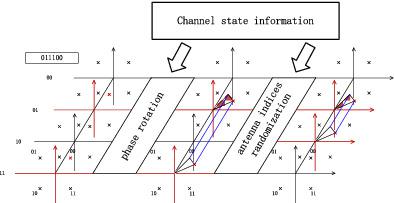当前位置:
X-MOL 学术
›
Trans. Emerg. Telecommun. Technol.
›
论文详情
Our official English website, www.x-mol.net, welcomes your feedback! (Note: you will need to create a separate account there.)
Secure transmission via random quadrature spatial modulation
Transactions on Emerging Telecommunications Technologies ( IF 3.6 ) Pub Date : 2020-07-06 , DOI: 10.1002/ett.4002 Xuanzhe Qi 1 , Junshan Luo 1 , Hao Wang 1 , Shilian Wang 1
Transactions on Emerging Telecommunications Technologies ( IF 3.6 ) Pub Date : 2020-07-06 , DOI: 10.1002/ett.4002 Xuanzhe Qi 1 , Junshan Luo 1 , Hao Wang 1 , Shilian Wang 1
Affiliation

|
In this article, we propose a random quadrature spatial modulation (RQSM) scheme to achieve secure transmission in multiple‐input multiple‐output multiantenna eavesdropper channels. We consider the case in which the eavesdropper has more antennas than that of the legitimate receiver, leading to a strong wiretap channel. In this case, the conventional secure quadrature spatial modulation schemes based on the artificially interfering signals are vulnerable to eavesdropping. On the contrary, the proposed RQSM scheme is able to achieve the physical‐layer security without transmitting artificial noises. Specifically, the bits‐to‐symbol mapping of the proposed RQSM is randomized according to the instantaneous channel state information of the legitimate link. Since in a rich scattering environment, the legitimate and the wiretap channels are generally independent of each other due to the spatial decorrelation property. Thus, the eavesdropper can be considered ignorant of the legitimate channel and cannot decode the confidential messages correctly. We derive the ergodic secrecy rate of the proposed RQSM scheme and show that the secrecy performance does not degrade as the number of antennas at the eavesdropper increases, which also outperforms the conventional jamming strategies. In addition, the bit error rate of the RQSM is also analyzed, which shows that security is achieved without sacrificing the system's reliability. Numerical results validate the theoretical derivations and demonstrate the effectiveness of the proposed RQSM scheme.
中文翻译:

通过随机正交空间调制进行安全传输
在本文中,我们提出了一种随机正交空间调制(RQSM)方案,以在多输入多输出多天线窃听通道中实现安全传输。我们考虑以下情况:窃听者的天线多于合法接收者的天线,从而导致强大的窃听通道。在这种情况下,基于人为干扰信号的常规安全正交空间调制方案容易受到窃听。相反,提出的RQSM方案能够在不传输人为噪声的情况下实现物理层安全性。具体而言,根据合法链路的瞬时信道状态信息,对所提出的RQSM的比特到符号映射进行了随机化。由于在散射环境丰富的情况下,由于空间去相关特性,合法通道和窃听通道通常彼此独立。因此,窃听者可以被认为是不知道合法信道的,并且不能正确地解码机密消息。我们推导了所提出的RQSM方案的遍历保密率,并表明,随着窃听者天线数量的增加,保密性能不会降低,这也优于传统的干扰策略。此外,还分析了RQSM的误码率,这表明在不牺牲系统可靠性的前提下实现了安全性。数值结果验证了理论推导并证明了所提出的RQSM方案的有效性。窃听者可被视为对合法频道不了解,并且无法正确解码机密消息。我们推导了所提出的RQSM方案的遍历保密率,并表明,随着窃听者天线数量的增加,保密性能不会降低,这也优于传统的干扰策略。此外,还分析了RQSM的误码率,这表明在不牺牲系统可靠性的前提下实现了安全性。数值结果验证了理论推导并证明了所提出的RQSM方案的有效性。窃听者可被视为对合法频道不了解,并且无法正确解码机密消息。我们推导了所提出的RQSM方案的遍历保密率,并表明,随着窃听者天线数量的增加,保密性能不会降低,这也优于传统的干扰策略。此外,还分析了RQSM的误码率,这表明在不牺牲系统可靠性的前提下实现了安全性。数值结果验证了理论推导并证明了所提出的RQSM方案的有效性。我们推导了所提出的RQSM方案的遍历保密率,并表明,随着窃听者天线数量的增加,保密性能不会降低,这也优于传统的干扰策略。此外,还分析了RQSM的误码率,这表明在不牺牲系统可靠性的前提下实现了安全性。数值结果验证了理论推导并证明了所提出的RQSM方案的有效性。我们推导了所提出的RQSM方案的遍历保密率,并表明,随着窃听者天线数量的增加,保密性能不会降低,这也优于传统的干扰策略。此外,还分析了RQSM的误码率,这表明在不牺牲系统可靠性的前提下实现了安全性。数值结果验证了理论推导并证明了所提出的RQSM方案的有效性。
更新日期:2020-07-06
中文翻译:

通过随机正交空间调制进行安全传输
在本文中,我们提出了一种随机正交空间调制(RQSM)方案,以在多输入多输出多天线窃听通道中实现安全传输。我们考虑以下情况:窃听者的天线多于合法接收者的天线,从而导致强大的窃听通道。在这种情况下,基于人为干扰信号的常规安全正交空间调制方案容易受到窃听。相反,提出的RQSM方案能够在不传输人为噪声的情况下实现物理层安全性。具体而言,根据合法链路的瞬时信道状态信息,对所提出的RQSM的比特到符号映射进行了随机化。由于在散射环境丰富的情况下,由于空间去相关特性,合法通道和窃听通道通常彼此独立。因此,窃听者可以被认为是不知道合法信道的,并且不能正确地解码机密消息。我们推导了所提出的RQSM方案的遍历保密率,并表明,随着窃听者天线数量的增加,保密性能不会降低,这也优于传统的干扰策略。此外,还分析了RQSM的误码率,这表明在不牺牲系统可靠性的前提下实现了安全性。数值结果验证了理论推导并证明了所提出的RQSM方案的有效性。窃听者可被视为对合法频道不了解,并且无法正确解码机密消息。我们推导了所提出的RQSM方案的遍历保密率,并表明,随着窃听者天线数量的增加,保密性能不会降低,这也优于传统的干扰策略。此外,还分析了RQSM的误码率,这表明在不牺牲系统可靠性的前提下实现了安全性。数值结果验证了理论推导并证明了所提出的RQSM方案的有效性。窃听者可被视为对合法频道不了解,并且无法正确解码机密消息。我们推导了所提出的RQSM方案的遍历保密率,并表明,随着窃听者天线数量的增加,保密性能不会降低,这也优于传统的干扰策略。此外,还分析了RQSM的误码率,这表明在不牺牲系统可靠性的前提下实现了安全性。数值结果验证了理论推导并证明了所提出的RQSM方案的有效性。我们推导了所提出的RQSM方案的遍历保密率,并表明,随着窃听者天线数量的增加,保密性能不会降低,这也优于传统的干扰策略。此外,还分析了RQSM的误码率,这表明在不牺牲系统可靠性的前提下实现了安全性。数值结果验证了理论推导并证明了所提出的RQSM方案的有效性。我们推导了所提出的RQSM方案的遍历保密率,并表明,随着窃听者天线数量的增加,保密性能不会降低,这也优于传统的干扰策略。此外,还分析了RQSM的误码率,这表明在不牺牲系统可靠性的前提下实现了安全性。数值结果验证了理论推导并证明了所提出的RQSM方案的有效性。



























 京公网安备 11010802027423号
京公网安备 11010802027423号